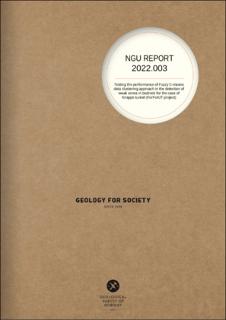| dc.contributor.author | Tassis, Georgios | |
| dc.contributor.author | Wang, Ying | |
| dc.contributor.author | Rønning, Jan Steinar | |
| dc.coverage.spatial | 11151 Bergen | |
| dc.date.accessioned | 2024-01-04T12:53:37Z | |
| dc.date.available | 2024-01-04T12:53:37Z | |
| dc.date.issued | 2023 | |
| dc.identifier.issn | 0800-3416 | |
| dc.identifier.uri | https://hdl.handle.net/11250/3109852 | |
| dc.description.abstract | Near-surface geophysical applications employing multiple 2D methods that are mapping multiple properties along co-located profiles, enable new possibilities in exploring subsurface structures. Diverse data sets can now be cooperatively interpreted with the use of cluster analysis which is an unsupervised machine learning method that helps to explore patterns in data and separate them into groups based on similarity. In this report, we present our first attempt in testing this novel 2D method by applying cluster analysis on our previously published results from parts of the Knappe-tunnel.
The now completed 3.8 km long Knappe tunnel west of the city of Bergen is a site where multimethod-based exploration is available but also a test area where resulting clustering interpretations can be directly compared to bedrock quality estimations carried out after its completion. In this framework, resistivity and P-wave velocity values for co-located profiles were automatically classified with the use of Fuzzy C-means clustering method. Two independent implementations of this method were utilized: one in-house ran by NGU-researcher Ying Wang, and another provided and ran by Dr Beatriz Benjumea of the Geological Survey of Spain. Hence, a large variety of 2D results were produced, enabling inherently joint interpretation of possible weak zones, in addition to those already extracted directly from the ERT and Refraction Seismic inversion results. Through this procedure we were able to test the performance of the Fuzzy C-means method independently and evaluate how systematic clustering results are, coming from two different algorithms.
Our results indicate that we were not able to utilize cluster analysis in full in this first attempt due to limited knowledge concerning applicability of the method on vertical 2D geophysical profiling. However, new ideas and approaches were inspired that will be pursued in the future. | |
| dc.language.iso | nor | |
| dc.publisher | Norges geologiske undersøkelse | |
| dc.relation.ispartofseries | NGU-Rapport (2022.003) | |
| dc.rights | Navngivelse 4.0 Internasjonal | |
| dc.rights.uri | http://creativecommons.org/licenses/by/4.0/deed.no | |
| dc.subject | REFRAKSJONSSEISMIKK | |
| dc.subject | BERGGRUNN | |
| dc.subject | RESISTIVITET | |
| dc.subject | SPREKKESONE | |
| dc.subject | GEOFYSIKK | |
| dc.title | Testing the performance of Fuzzy C-means data clustering approach in the detection of weak zones in bedrock for the case of Knappe tunnel (ForForUT project) | |
| dc.type | Report | |
| dc.description.localcode | 69021 | |
| dc.source.pagenumber | 44 s. | |
| dc.relation.project | 329500 | |

